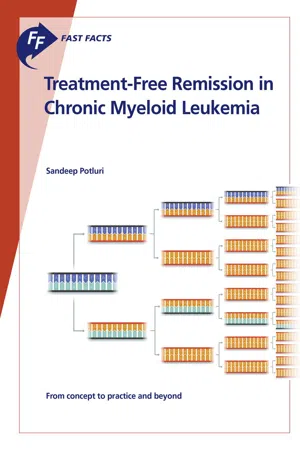
Fast Facts: Treatment-Free Remission in Chronic Myeloid Leukemia
From concept to practice and beyond
S. Potluri
- 56 pages
- English
- ePUB (mobile friendly)
- Available on iOS & Android
Fast Facts: Treatment-Free Remission in Chronic Myeloid Leukemia
From concept to practice and beyond
S. Potluri
About This Book
The tyrosine kinase inhibitor (TKI) imatinib was the first treatment to specifically target cancer cells, rather than the relatively indiscriminate effects of conventional chemotherapy on any rapidly dividing cells. This concept of targeted treatment in cancer is one of the important advances in modern medicine in the last 30 years. Indeed, treatment with TKIs has transformed chronic myeloid leukemia (CML) from a cancer with a poor prognosis to one in which many patients can expect a normal lifespan. Success with the TKIs has prompted the question of whether it is desirable – or feasible – for patients to remain on treatment for long periods. While the TKIs are targeted, they are associated with considerable toxicity, and long-term treatment has important economic implications for health services and patients. Thus, the concept of treatment-free remission (TFR) has emerged for patients in deep clinical remission. Clinical research over the last decade has focused on whether treatment can be stopped, how to best monitor patients while off treatment, and how to intervene before a clinical relapse. As this research progresses, the tantalizing prospect of a cure for some patients seems increasingly feasible. This new Fast Facts title outlines this trail-blazing approach to the long-term management of patients living with CML in remission. It explains the concepts of molecular and hematologic relapse, the highly sensitive technologies that allow disease monitoring, and how TFR is best managed in practice. It is a concise educational resource, ideal for any healthcare professional involved in the treatment of patients with CML who wants to understand TFR, particularly clinical nurse specialists and pharmacists who increasingly help clinicians to run CML clinics. Table of Contents: • The concept of treatment-free remission • Measurement of disease burden • Clinical practice • Future directions
Frequently asked questions
Information
| 2 | Measurement of disease burden |
| TABLE 2.1 Methods for identifying remission, in order of increasing sensitivity | ||
| Method | Type of remission | Definition |
| Full blood count – levels of each cell type on blood film (see Figure 2.1a) | Complete hematologic remission | Platelet count < 450 × 109/L White cell count < 10 × 109/L No immature granulocytes Basophils < 5% of all white blood cells |
| Giemsa banding karyotyping to identify the Philadelphia chromosome; cells are treated with colchicine to arrest as many as possible in metaphase of mitosis (see Figure 2.1b) | Complete cytogenetic remission | No visible Philadelphia chromosomes |
| FISH: different color fluorescent probes are hybridized to BCR and ABL1 (see Figure 2.1c) | Complete cytogenetic remission | In normal cells, the two probes appear slightly separated on confocal microscopy as BCR and ABL1 are on different chromosomes In CML cells with the BCR–ABL1 transcript, the two probes appear in the same place |
| PCR: used to detect BCR–ABL1 transcript | Complete molecular remission | No detectable BCR–ABL1 transcripts |
| NGS: sensitive to 1 abnormal cell in 100 million normal cells | Complete NGS remission | No detectable BCR–ABL1 transcripts |
| CML, chronic myeloid leukemia; FISH, fluorescence in situ hybridization; NGS, next-generation sequencing; PCR, polymerase chain reaction. | ||

| TABLE 2.2 European LeukemiaNet guidelines’ stratification of responses to tyrosine kinase inhibitors1 | |||
| Time | Optimal response | Warning | Failure |
| Baseline | High-risk clonal chromosomal abnormalities | ||
| 3 months | BCR–ABL1IS ≤ 10% and/or Ph+ ≤ 35% | BCR–ABL1IS > 10% and/or Ph+ 36–95% | No CHR and/or Ph+ > 95% |
| 6 months | BCR–ABL1IS < 1% and/or Ph+ 0% | BCR–ABL1IS 1–10% and/or Ph+ 1–35% | BCR–ABL1IS > 10% and/or Ph+ > 35% |
| 12 months | BCR–ABL1IS ≤ 0.1% | BCR–ABL1IS > 0.1–1% | BCR–ABL1IS > 1% and/or Ph+ > 0% |
| Any subsequent time | BCR–ABL1IS ≤ 0.1% | New −7 or −7q karyotype | Any of: Loss of CHR, or cytogenetic remission on one measurement Loss of BCR–ABL1IS ≤ 0.1% on two consecutive measurements Tyrosine kinase domain mutations New clonal chromosomal abnormalities |
| CHR, complete hematologic remission; IS, International Scale (see page 25); Ph+, Philadelphia chromosome positive. | |||
Polymerase chain reaction

Table of contents
- Cover
- Title Page
- Copyright
- Contents
- List of abbreviations
- Introduction
- The concept of treatment-free remission
- Measurement of disease burden
- Clinical practice
- Future directions
- Useful resources
- Index